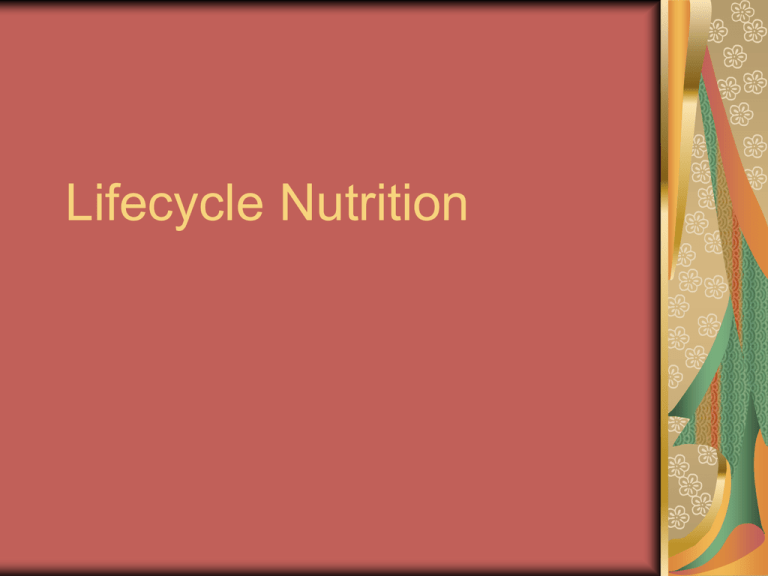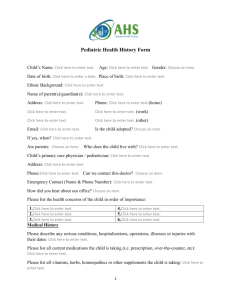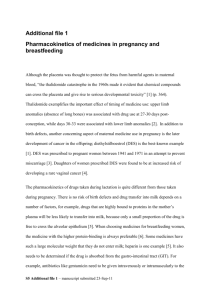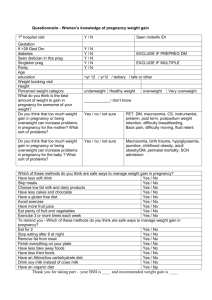Lifecycle Nutrition - Central Washington University
advertisement

Lifecycle Nutrition Developmental Nutrition FCSN 345 Dr. Virginia Bennett Office 134 PE Office hours: T & Th 1:00 e-mail: bennettv@cwu.edu Measures of a Successful Outcome of Pregnancy Healthy Baby Healthy Mother Baby Survives the First Year of Life Healthy Baby Still Birth Ratio or Fetal Death Ratio Early in Pregnancy: difficult to have reliable numbers of death rate Why? Later in Pregnancy: numbers are more reliable after 20 wks gestation About 6.4 stillbirths per 1000 live births Healthy Mother: Maternal Mortality Static since 1982 at 7 to 8 mothers die per 100,000 births. About 1 death per day in the US Big racial difference: White 5.0 Black 20.8 Others 18.2 Why? Maternal Mortality Infant Mortality Infancy: First Year of Life <28 days - neonatal >28 days < 1 year - postneonatal 2006: Infant Mortality Rate in US 6.43 per 1000 live births Ranked 42nd world-wide 1950 29.2 but we were ranked 6th worldwide Why? terminology Infant: first year of life Neonatal: under 28 days of life Early Neonatal: under 7 days of life Post neonatal: 28 days – 11 months Fetal mortality: fetal deaths over 20 weeks gestation Late Fetal mortality: deaths over 28 weeks gestation Cause of Infant Problems Neonatal Problems: first 28 days after birth What might be the reasons for problems here? 4.7 in 2002 Post neonatal Problems: 28 days to one year What might be the reasons for problems here? 2.3 in 2002 In US Most infant deaths happen in neonatal period Perinatal mortality: adds fetal deaths plus early neonatal deaths Better Infant Mortality Rates Japan: 3.24 Singapore: 2.29 Sweden: 2.76 Hong Kong 2.95 Cuba 6.22 CIA - The World Factbook -- Rank Order - Infant mortality rate Risk of Infant Mortality: Factors If infant mortality rate was similar to Singapore’s we would save over 18,900 infant deaths per year Low Birth Weight largest single factor less than 5.5 pounds (2500 grams) LBW risk factors: K maternal pre-pregnancy ht & wt and pregnancy weight gain age socioeconomic poverty number of pregnancies race Classification of Low Birth Weight Premature < 37 weeks Intrauterine Growth Retardation or Small for Gestational Age 37 weeks wasted - thin, wt, normal Infant Mortality Rates by Maternal Race 14 12 10 8 6 4 2 0 White Black Native Amer Asian or All Races Pacific Islander Mechanism for growth retardation Maternal Malnutriton Reduced blood volume expansion Inadequate increase in cardiac ouput Decreased placental blood flow Decreased placental size Reduced nutrient transfer Fetal Growth Retardation How to improve Infant Mortality Rate? Housing Sanitation Diet Health care Nutrition Influences on Fetal Growth Deficiency in Calories Too few Calories to allow adequate reproduction of cells and decreased development Deficiency of Nutrients Too little of some specific nutrient e.g.: folic acid spina bifida Spina Bifida: A Neural Tube Defect Winick: Growth Happens in Two Ways Increased number of cells Increased size of cells Critical times of increased number of cells 1. Increased number hyperplasia 2. Number and size hypertrophy + Critical Periods If an embryo or fetus doesn’t receive the nutrition necessary to help with development, the fetus will suffer Fertilization of the ovum(zygote) happens implantation of the ovum in the uterine wall happens in the first two weeks Critical period: cigarette smoke, malnutrition can keep development from Types of Fetal Growth Failure Intrinsic: some internal factor chromosome abnormalities drug affecting cells Extrinsic: some external factor poor intake of nutrients poor blood supply Is the fetus a perfect parasite? What does this mean? Fetus takes what it needs regardless of mother’s intake Probably isn’t true. It takes what it needs until it disrupts mother’s ability to survive From a species survival standpoint: mother needs to survive Events of Pregnancy Time Event 0-2 weeks egg fertilized and implanted 3-8 weeks Embryo: at end of 8 weeks is 1 inch and has central nervous system, GI tract, limb, buds, etc. 8-40 weeks Fetal period: growth and development Role of the Placenta Nutrient and waste product exchange Hormone production Estrogen: helps develop the infrastructure of pregnancy Progesterone: Relaxes smooth muscle Relaxes the uterus Relaxes the digestive system: slower Placenta Roles Transport Mechanisms: Passive Diffusion: Oxygen -Carbon dioxide Fatty acids-Steroids Nucleosides -Electrolytes Fat-soluble vitamins Role of the Placenta Placenta is Selectively Permeable Not all molecules can cross the placenta Vitamin D can Parathyroid Hormone (PTH) can’t Allows for bone remodeling Placental Transport Facilitated Diffusion: Most monosaccharides Active Transport: Amino acids --some cations (Ca, Iron) Iodine --Phosphate Water-soluble vitamins (at high concentrations Vitamin C can pass via diffusion) Solvent Drag: electrolytes Pregnancy Nutrient Needs to Support Pregnancy Energy: No increase in Cal for first trimester Why?: 1. Very small embryo; 2. Increased absorption of most nutrients and Cal due to decreased motility of GI tract due to hormones of pregnancy 300 Cal increase during 2nd and Nutrient Needs During Pregnancy Protein: Determine pre-pregnancy needs based on RDA: 0.8 grams protein/kg. This is generally around 45 to 50 grams Protein per day. Add 15 grams to this for pregnancy Generally around 60 to 65 grams/day is sufficient Methylated Molecule SAH Molecule SAM Homocysteine Methyl-H4 Folate Methylene-H4 Folate Methionine B12 H4 Folate serine glycine purine Purine precursor Nutrients of Special Interest Folate: related to neural tube defects and spina bifida Reduced absorption during pregnancy because of interaction with estrogen Produces folate deficient women Interferes with proper formation of spinal column: affects 400,000 births per year Nutrients of Special Interest Iron: Blood volume increases by 50% during pregnancy Body conserves Iron during pregnancy No menstruation 3 time increase in absorption But still doesn’t keep up with production of red blood cells Hemoglobin concentration falls: normal above 13 g/dl. In pregnancy may fall below 12 g/dl RDA up from 15 to 30 mg/day Special Supplemental Food Program for Women, Infants, and Children To battle against problems during pregnancy and infancy, WIC was developed to provide supplemental food to low socioeconomic and at risk women and infants. Nutrition education also provided Recent study: for each $1 spent, $4 save down the road; Avg costs: Normal Birth Weight= $1,700; Premie or low birth weight = $77,000 Information on WIC http://www.fns.usda.gov/wic/ In 2005 we had about 8 million receiving WIC assistance in the US; This cost about $1.4 Billion In 2005 we had about 160,000 receiving WIC assistance in Washington; This cost about $28 Million dollars Body Mass Index Kg/ meters 2 175#/2.2 #/kg = 79.5 kg 72 “ X .0254 meters/inch = 1.83 meters 1.83 meters 2 = 3.35 79.5 / 3.35 = 23.7 Weight Gain During Pregnancy Based on Pre-pregnancy BMI Underweight (BMI<19.8) : 28-40 # Normal weight(BMI 19.8-26) : 25 to 35 # Overweight(BMI 26-29): 15 to 25 # Obese(BMI over 29): 13 # minimum Other Modifiers: Small stature(<62 in) : low end of range; black: high end of range Wt Gain for multifetal pregnancies Twins: 35-45 lbs. Underwt at the upper end of range; overwt at the lower end 4-6 lb first trimester; 1.5 lb/wk after 450 Cal per day above prepregnancy amount Triplets: 50 lbs with 1.5 lb/wk throughout pregnancy Cal intake should reflect enough intake to meet wt gain goals Average weight of multifetal pregnancies Singletons: 7.7 lbs(3440 grams) Mean gestational age: 39-40 wks 6% lbw Twins: 5.4 lbs(2400 grams) 37 weeks; 54 % lbw Triplets: 4.0 lbs(1800 grams) 33-34 wks; 90% lbw Rate of Weight Gain First Trimester: 2 to 4 pounds Second and Third Trimester: 1 pound per week 3 pounds + (26 weeks x 1 # per week) = 29# Components of Weight Gain Infant 7.5 # amniotic fluid 2 # Placenta 1.5 # mother’s stores 7 # Blood 4 # Fluid 4 # uterus 2 # Breasts 2 # TOTAL 30 # Fetal Alcohol Syndrome Physical and Mental Abnormalities attributed to alcohol consumption during pregnancy low nasal bridge small head short nose circumference short eyelid opening delayed thin upper lip development underdeveloped filtrum Source of FAS Information http://www.nofas.or g/ http://capwiz.com/n ofas/issues/alert/?a lertid=6804721&typ e=CO Advocacy Extra credit assignment: write a letter to your members of congress FAS Screening In 1996, FAS Facial Photographic Screening/Diagnostic software (Astley & Clarren, 1996; 2001; Astley et al., 2001; Astley & Kinzel, 2002). The software is used to measure the magnitude of expression of the three facial features of FAS (small eyes, a smooth philtrum and a thin upper lip). FAS Screening FAS is characterized by growth deficiency, a unique cluster of facial features, cognitive/behavioral problems and prenatal alcohol exposure. The facial appearance is the only feature that is unique to FAS, thus it serves as an ideal feature to use for screening. The screening tool performed with 99.9% accuracy. Alcohol Effects on Pregnancy About 1/5 of women continue to during pregnancy The first few weeks are critical; many women don’t know they are pregnant Birth defects have occurred in women who consume as little as two drinks per day No alcohol is the best if planning pregnancy Fetal Alcohol Effects: internal damage Other Dietary Concerns during Pregnancy Caffeine: Animal models: massive doses are teratogenic Smaller doses not as definitive mixed results in epidemiological studies generally if caffeine is consumed, it should be moderately Sugar Substitutes Saccharin: A carcinogen? Limit during pregnancy Doses relationship: high intake = greater risk Aspartame (Nutrasweet): PKU mothers should avoid If not PKU, moderate intake probably ok but need to increase Cal (2nd and 3rd trimesters) and Calcium Maternal Problems of Pregnancy Gestational Diabetes: Glucose Intolerance Hormones of pregnancy make mother’s body resistant to insulin;Human Placental Lactogen (HPL); Human Growth Hormone(HGH) Often shows up at 25 weeks of pregnancy Needs to be treated to control growth of the fetus Macrosomia: large baby and delivery Gestational Diabetes Dx Glucose Tolerance Test (GTT): After Fasting: Glucose Load given orally Baseline Blood Glucose (BG) BG’s every hour for three hours two abnormally high values indicate Db Dx Normal BG values Fasting 1 hr 2 hr 3 hr 105 mg/dl 190 165 145 Normal and Abnormal Glucose Curves 250 200 150 normal Db 100 Db 50 0 fasting 1 hours 2 hours 3 hours Treatment of Gestational Db Diet alone Calculate CHO needed: Generally 50 % of Cal Could be less if poor control Distribute them throughout the day Develop and Meal Plan for Mother Involves Food Records Weight Checks Ketone Testing Blood Glucose Testing Gestational Db Treatment Diet and Insulin Some individuals are never able to control BG by diet alone and require insulin injections Same concerns as diet alone With emphasis on hypoglycemia Gestational Diabetes Resources American Diabetes Association http://www.diabetes.org/gestationaldiabetes.jsp Other Problems of Pregnancy Edema: most women suffer from water retention: due to large blood volume and decreased protein concentration in blood Pregnancy Induced Hypertension (PIH) massive edema, high blood pressure, protein in urine If untreated can result in fetal and maternal injury or death PIH: formerly called Toxemia Elevated BP Proteinuria Massive edema Often called preeclampsia Eclampsia: a result of severe preeclampsia: convulsions and coma Can result in the death of the mother and fetus Treatment of PIH: Diet?? Nutritionally: offset protein loss with additional protein in diet Some research shows calcium supplementation may help prevent; mixed Magnesium supplementation may help Sodium restriction DOES NOT HELP treat or prevent Treatment of PIH: Diet?? Antioxidants: Vit C, E, carotene Hypertension often requires blood pressure lowering medication Depending on severity, may require bedrest Pica and Cravings Pica: Eating Non-foods geophagia: eating dirt Iron deficiency?: problem if it causes a blockage amylophagia: eating clothing starch Cravings: eg: dill pickles and ice cream reason? Overcome a deficiency? No harm, no need for concern: If harmful, intervention is needed Nutritional Guidance During Pregnancy Positive approach to nutrition and pregnancy Stress positive outcomes Vs fear of negative outcome Stress the importance of good nutrition adequate protein of good quality enough total Cal, esp CHO, to spare protein balance of vitamins and minerals from Nutrition and Pregnancy Age and Parity of Mother Preconception Nutrition Metabolic Interaction of Pregnancy: synergism Individual needs and adaptations Nutrition Assessment Clinical Observations Body Measures Lab Tests Diet History Lab Tests Can Indicate Problems Anemia of Pregnancy Iron Deficiency: Most Common also called microcytic, hypochromic, with reticulocytes( immature RBCs) treated with supplements of Iron (30 mg/day) Other Anemias: Folic Acid deficiencyalso called megaloblastic anemia; disrupts hemoglobin synthesis B12 Deficiency: Called pernicious; also big cells Blood measures: Anemia Hematocrit: Packed RBC Volume Normal non-pregnancy: 35 % During pregnancy 29-31% Hemoglobin Normal non-pregnancy: 13-14 g/100ml Pregnancy: 10-11 g/100ml Images of Anemia http://health.allrefer.com/health/irondeficiency-anemia-reticulocytes.html Folic Acid Anemia RDA up from 180 micrograms to 400 micrograms / day Estrogen Folic Acid Interactions 1. Disrupts absorption disrupts an enzyme that helps with absorption(deconjugase) 2. Increases clearance of folic acid from blood B12 Deficiency Pernicious Anemia similar to megaloblastic but caused by deficiency of B12 If untreated, may also be associated with neurological damage http://health.allrefer.com/picturesimages/megaloblastic-anemia-viewof-red-blood-cells.html Phenylketonuria and Pregnancy PKU: genetic disease, passed autosomal recessive trait Inability to metabolize extra Phe to Tyrosine missing Phenylalanine hydroxylase results in high phenylketones in mother and fetal circulation can cause mental retardation in fetus Red Flags During Assessment Disproportionate height to weight and weight gain Abuse or avoidance of foods bizarre eating patterns economic or psychological problems associated with food unhealthful lifestyle with or without substance abuse Lactation 3 Factors to Establish and Maintain Breastfeeding Anatomy Initiation of production Ejection of milk from alveoli Anatomy Functional Breasts Large variation in structure But almost all women who have given birth who want to breastfeed their babies can Development of Breasts Puberty: increased estrogen associated with development of mammary glands and alveolar cells and ducts Pregnancy: further proliferation of alveoli Birth: increase prolactin production and secretion Further alveolar cell proliferation Physiology of Lactation Full Lactation may not be attained until 2nd or even 3rd week (in first pregnancy) Colostrum: first secretion: high in protein, low in sugar and fat First 2+ days and then transition to milk Yellow high in immunoglobulins Prolactin: Control of Milk Production Complex neuroendocrine process Sensory nerves of breast stimulated nerve impulse travels to spinal cord and hypothalamus Induces pituitary gland to produce and secrete hormones – Major one is PROLACTIN Cycle of Production Resting Cell Milk synthesis Milk secretion Resting Cell Prolactin Control Fat Prolactin increases two enzymes Induces lipoprotein lipase production which removes Triglycerides from circulation and moves fatty acids and glycerol into alveolar cells Induces a transferase enzyme that helps make triglycerides in the cell for milk production Prolactin Control Protein: casein and lactalbumin unique to milk Prolactin increases production of these two proteins Prolactin Control CHO: lactose Galactosyl transferase(inactive) | lactalbumin | Galactosyl transferase(GT)(active) Glu + Gal-----------> Lactose GT Maintenance of Milk Production Sucking---hypothalamus--anterior pituitary---prolactin secretion---milk production and release If no sucking No milk production Demand and Supply less sucking, less production: more sucking, more production Milk Letdown: moving the milk to nipple for baby access Controlled by oxytocin Sucking----hypothalamus--posterior pituitary-----oxytocin release myoepithilial cell contraction in ductules forces milk to nipple Other stimuli can induce this as well crying, embarrassment Human Vs Cow’s milk(per Liter) Kcal: Pro(g): % Fat(g): % CHO(g) % 668 9 5.5% 40 53.9% 68 40.7% 678 35 20.6% 38 50.4% 49 28.9% Protein Content of Milk Species specific: The fastest newborn growth rate = the highest level of protein Cows grow real fast, therefore cow’s milk has relatively more protein than human milk. Why is more protein needed in cow’s milk? Type of protein in milk Human milk 40 % Casein, 60 % alpha lactalbumin Cow’s milk 80 % Casein, 20 % alpha lactalbumin Human milk low in Phenylalanine Human milk high in cystine & taurine Babies can’t synthesize these too well. Taurine: a conditionally essential Amino Acid, not used in Protein Synthesis Found free or associated with small peptides: Taurine Function Taurine function: Functions: Related to development in infants Also conjugation of bile acids; Taurine, called a bile salt, is lipophilic and hydrophilic; these are conjugated or connected to bile acids, the combination of which helps emulsify the fatty stuff of food and helps with digestion and absorption; Taurine Function Other functions of taurine: detoxification, membrane stabilization, osmoregulation, and modulation of cellular calcium levels. Colostrum High protein low sugar, fat and kcal Immunoglobulins IgA and IgG guard against intestinal tract infection may pass into circulation and guard against systemic infection passage of meconium helps establish bifidus flora in GI tract Iron Supplementation and BF Two Points of View: Yes: milk iron directly proportional to mother’s intake Fetal Fe levels are generally low; Fe needed for growth No: Fe saturates lactoferrin, the iron binding protein of milk lactoferrin then unable to sequester Fe from pathogenic bacteria; leading to more infections Vitamins: Cow Vs. Human The amount of vitamins in human milk varies more from individual to individual than does the average vitamin content of cow’s milk from the average vitamin content of human milk. Why? Diet, genetics, other factors Vitamin K and Infants Infants generally low Vitamin K status Intestinal flora make Vitamin K Newborn gut is sterile, no bacteria to make Vitamin K Birth is traumatic Vitamin K is important in blood clotting Vitamin K injection at birth Breastfeeding: Best Feeding Method ‘Sole’ food for the first 4 to 6 months Provides benefits to baby and mother Economic Nutrition Immune function Bonding Maternal weight loss Convenience Anti-infective Properties Bifidus factor: stimulates bifidobacteria, which fight against pathogenic bacteria IgA, IgM, IgG: immunoglobulins that guard the gut against infective bacteria Lactoferrin: binds iron away from bacteria Macrophages: phagocytosis of infective bacteria When not to breastfeed? HIV infected mother Although WHO says go ahead in developing countries The risk of infection is less than the harm by not having good nutrition available during early months Galactosemia: one in 50,000 births Inability to convert galactose to glucose and developmental problems result Breastfeeding Promotion Incidence: how many select breastfeeding as a feeding choice: Breastfeeding at 1 week Duration: how long does mother breastfeed? sole food for 5 to 6 months. By 2000, goals are 85% and 35% Peaked in 1984 at 61% and 24% dropping since Breastfeeding Choice: Factors Ethnicity: Anglo 60.5%; Black 25%; Hispanic: 51%; Employment: Full 53 %; Part 62 %; None 53 %; Acculturation: Low 53 %; Middle 38 %; High 36 %; Trisler, T. A., Bergman, E.A. JADA Suppl 93(9): A77. 4 groups of breastfeeding promotion A: no peer present: Spanish taught B: no peer present: English taught C: peer present: Spanish taught D. peer present: English taught Presence of peer played no role in incidence of breastfeeding; Spanish taught increased rate of incidence Behavioral Factors Involved in Breastfeeding Decision Social Support: availability of family members Social Influence; advertising, health professionals Attitudes:attitudes toward formula and BF Self-efficacy: confidence of the mother Summary: Must increase BF in minority populations How to Influence Choice? J Nutr Ed: Teaching Intervention 1984: 16(1): 19-22. Three groups: A: Pregnant woman given referral card with telephone number with supportive message B: Same with a manual in Spanish and English C: Same with a bedside teaching session with BF consultant JADA 1998;98:143-148. Counseling and Motivating videotapes increase duration of breast-feeding in African-American WIC participants n=115 Af-Am women who initiated BF Four groups: A: no intervention B: video package C: peer counseling D: both More breastfed in intervention groups JADA 1998 Group 7-10 d 8 wk 16 wk Control 53% 23%* 0%* video 67%(n=33)75%(n=28)48% vi&peer 80% 70% 40% *p<.05 If Breastfeeding is not Chosen? Infant formula is next best choice: Most are cow’s milk derived and are produced to be close to human milk in composition Some are soy based Others are specialized to meet certain needs e.g.: PKU babies can’t have very much phenylalanine in the diet: Lofenalac Nutrition Education Informative: Factual information Attitudinal: motivates change in attitude about nutrition and nourishment Behavioral: motivates change in behavior Therapeutic: addresses a specific problem When is Nut Ed needed? High Risk Groups: poverty, lack of education, very young(<17yo), very old (over 35 yo), first pregnancy, high parity, prior complications, lack of supportive environment. Education costs money: Cost/benefit needs to be established Money spent saves money Cost/Benefit of Nutrition Ed. WIC offers nutrition vouchers and nutrition education to high risk mothers. Data collected indicates that for each $1 spent, $4.21 is saved Individuals who don’t receive WIC are at greater risk for low birth weight babies, and other complications that lead to increased health care money spent. Nutrition Education Saves Money! Costs of Low Birth Baby Medicaid pays an average of $77,000 for a low birth weight baby in additional hospital and health care expenses. A normal weight baby costs an average of $1700. Poor Fetal Nutrition is also linked to Chronic Disease Lancet 348:1264-1268, 1996. N= 13,249 Death from heart disease and stroke tended to be higher in those men who were born with a low birth weight and remained small at 1 year of age Perhaps related to mother’s ability to support pregnancy and trauma induced in the developing fetus. Breastfeeding and Fertility Breastfeeding tends to suppress menstruation and ovulation Almost all who formula feed initiate menstruation and ovulation sooner Can this be used as a contraceptive method? Probably not. Nutritional status also influences. When to Add Solid Foods? 4 to 6 months: when developmental landmarks are met; Continue breastfeeding or formula Iron fortified rice cereal Add one food at a time: several days See if there is an allergic reaction Then add a new food Problems of Infant Feeding Failure to Thrive: Baby doesn’t grow as fast as peers Causes? Often inadequate nutrition Monitor weight gain Compare nutrient intake per body weight A baby needs more than an adult Problems of Infant Feeding Baby Bottle Tooth Decay: Also called Nursing Bottle Syndrome Exposure of teeth to the carbohydrates of formula General Feeding Rules for Infants and Children Caregiver is the gatekeeper: What is offered and when Infant or child decides whether to eat what is offered and also how much This is The New Font Color




